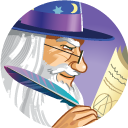Difference between revisions of "Number Systems"
From Coder Merlin
Dinas-emrys (talk | contribs) |
|||
| (5 intermediate revisions by 3 users not shown) | |||
| Line 2: | Line 2: | ||
{{MerlinCurriculumData|{{ROOTPAGENAME}}}} | {{MerlinCurriculumData|{{ROOTPAGENAME}}}} | ||
== Experience == | == Experience == | ||
{{ | {{MerlinMultipageExperienceSubpages | ||
|Pages=Positional Notation;Alternative Bases;Formal Representation;Conversions to Decimal;Conversions from Decimal;Customs;Shortcut Conversions | |||
}} | |||
| | |||
== Exercises == | == Exercises == | ||
{{ | {{Exercises| | ||
* {{MMMAssignment|M1011-10}} | |||
}} | |||
== References == | == References == | ||
* [https://en.wikipedia.org/wiki/Positional_notation Positional Notation] (Wikipedia) | * [https://en.wikipedia.org/wiki/Positional_notation Positional Notation] (Wikipedia) | ||
| Line 178: | Line 24: | ||
ability to convert between representations of numbers in the binary, octal, decimal, and hexadecimal systems; | ability to convert between representations of numbers in the binary, octal, decimal, and hexadecimal systems; | ||
}} | }} | ||
Latest revision as of 17:58, 8 January 2022
Within these castle walls be forged Mavens of Computer Science ...
— Merlin, The Coder
Curriculum[edit]
| Coder Merlin™ Computer Science Curriculum Data | |
|
Unit: Numbers Experience Name: Number Systems (W1011) Next Experience: () Knowledge and skills:
Topic areas: Positional notation Classroom time (average): 60 minutes Study time (average): 180 minutes Successful completion requires knowledge: understand positional notation Successful completion requires skills: ability to use positional notation to represent numbers in the binary, octal, decimal, and hexadecimal systems; ability to convert between representations of numbers in the binary, octal, decimal, and hexadecimal systems |
Experience[edit]
- Positional Notation
- Alternative Bases
- Formal Representation
- Conversions to Decimal
- Conversions from Decimal
- Customs
- Shortcut Conversions
Exercises[edit]
Exercises
- M1011-10 Complete Merlin Mission Manager Mission M1011-10.
References[edit]
- Positional Notation (Wikipedia)
- Radix (Wikipedia)
Experience Metadata
| Experience ID | W1011 |
|---|---|
| Next experience ID | |
| Unit | Numbers |
| Knowledge and skills | §10.311 |
| Topic areas | Positional notation |
| Classroom time | 60 minutes |
| Study time | 3 hours180 minutes <br /> |
| Acquired knowledge | understand positional notation |
| Acquired skill | ability to use positional notation to represent numbers in the binary, octal, decimal, and hexadecimal systems ability to convert between representations of numbers in the binary, octal, decimal, and hexadecimal systems |
| Additional categories |
